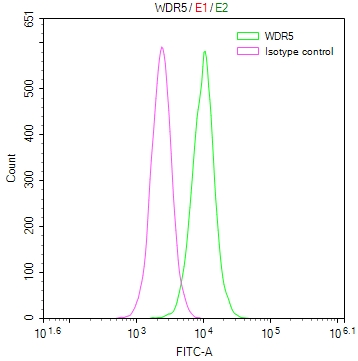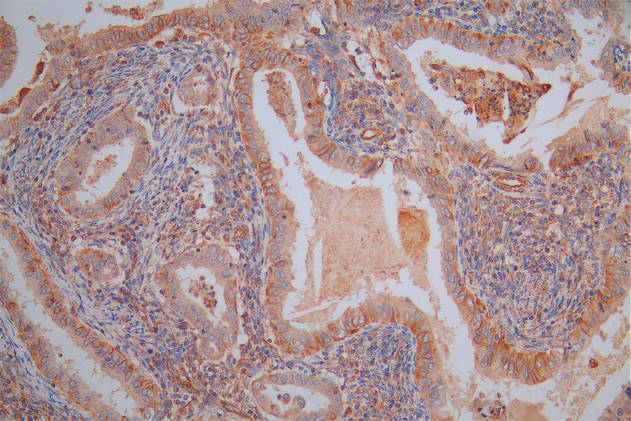RAI1 Antibody
-
中文名稱(chēng):RAI1兔多克隆抗體
-
貨號(hào):CSB-PA019291GA01HU
-
規(guī)格:¥3,900
-
其他:
產(chǎn)品詳情
-
Uniprot No.:
-
基因名:RAI1
-
別名:RAI1 antibody; KIAA1820 antibody; Retinoic acid-induced protein 1 antibody
-
宿主:Rabbit
-
反應(yīng)種屬:Human,Mouse,Rat
-
免疫原:Human RAI1
-
免疫原種屬:Homo sapiens (Human)
-
抗體亞型:IgG
-
純化方式:Antigen Affinity purified
-
濃度:It differs from different batches. Please contact us to confirm it.
-
保存緩沖液:PBS with 0.02% Sodium Azide, 50% Glycerol, pH 7.3. -20°C, Avoid freeze / thaw cycles.
-
產(chǎn)品提供形式:Liquid
-
應(yīng)用范圍:ELISA,WB
-
Protocols:
-
儲(chǔ)存條件:Upon receipt, store at -20°C or -80°C. Avoid repeated freeze.
-
貨期:Basically, we can dispatch the products out in 1-3 working days after receiving your orders. Delivery time maybe differs from different purchasing way or location, please kindly consult your local distributors for specific delivery time.
-
用途:For Research Use Only. Not for use in diagnostic or therapeutic procedures.
相關(guān)產(chǎn)品
靶點(diǎn)詳情
-
功能:Transcriptional regulator of the circadian clock components: CLOCK, ARNTL/BMAL1, ARNTL2/BMAL2, PER1/3, CRY1/2, NR1D1/2 and RORA/C. Positively regulates the transcriptional activity of CLOCK a core component of the circadian clock. Regulates transcription through chromatin remodeling by interacting with other proteins in chromatin as well as proteins in the basic transcriptional machinery. May be important for embryonic and postnatal development. May be involved in neuronal differentiation.
-
基因功能參考文獻(xiàn):
- This study identified from multiethnic meta-analyses stronger associations between the RAI1 locus and non-REM apnea-hypopnea index in men compared with women. PMID: 29077507
- This study provides information about the inheritance pattern and recurrence risk for patients with identified variants and demonstrates clinical and genetic overlap of neurodevelopmental disorders PMID: 28213671
- we report molecular and clinical characterizations of six subjects with the reciprocal phenomenon of deletions spanning both genes, i.e., PMP22-RAI1 deletions. Systematic clinical studies revealed features consistent with SMS, including features of intellectual disability, speech and gross motor delays, behavioral problems and ocular abnormalities. PMID: 27386852
- Mutations in RAI1, OTOF, and SLC26A4 may have roles in nonsyndromic hearing loss in Altaian families in Siberia PMID: 27082237
- South American cohort did not confirm the effect of the four candidate loci as modifier of onset age: mithocondrial A10398G polymorphism and CAGn at RAI1, CACNA1A, ATXN3, and ATXN7 genes PMID: 25869926
- RAI1 Gene Duplication is associated with Potocki-Lupski syndrome. PMID: 26544804
- Results show that when MBD5 and RAI1 are haploinsufficient, they perturb several common pathways that are linked to neuronal and behavioral development. PMID: 25853262
- Human RAI1 protein was found to be a highly expressed neuronal protein whose distribution matches well with its role in cognitive and motor skills. PMID: 24519454
- RAI1 gene polyglutamine repeat has a different distribution in our population. The 14-repeat allele is associated with perinatal depression and more frequent experience of physical and psychological symptoms during menstrual period. PMID: 24751306
- evolutionary conservation of chromatin binding of SPBP and RAI1 PMID: 24205348
- The Shc family protein adaptor, Rai, acts as a negative regulator of Th17 and Th1 cell development. PMID: 23345394
- A reduction of total RAI1 transcription factor activity is at the heart of the Smith-Magenis Syndrome clinical presentation. PMID: 23028815
- RAI1 is a positive transcriptional regulator of CLOCK, pinpointing a novel and important role for this gene in the circadian oscillator PMID: 22578325
- Mutation screening of the coding region of the RAI1 gene in patients with with features suggestive of Smith-Magenis syndrome identified two patients with novel heterozygous nonsynonymous alterations of unknown significance. PMID: 21897445
- Data suggest that RAI1 expression emerged as a genetic target for development of therapeutic interventions for SMS. PMID: 21857958
- Abnormal circadian rhythm of melatonin in Smith-Magenis syndrome patients with RAI1 point mutations PMID: 21739587
- Functional studies have shown that RAI1 gene dosage is crucial for normal regulation of circadian rhythm, lipid metabolism and neurotransmitter function. PMID: 21545756
- haploinsufficiency affects feeding, satiety and fat deposition patterns; RAI1 directly regulates the expression of BDNF PMID: 20663924
- data on 2 cases of Smith-Magenis syndrome with mutation of RAI1; sequencing of RAI1 revealed mutation of the same heptameric C-tract (CCCCCCC) in exon 3 in both cases (c.3103delC one case and and c.3103insC in the other), resulting in frameshift mutations PMID: 20932317
- Results indicate that transcription factor activity and subcellular localization signals reside in two separate domains of the protein and both are essential for the correct functionality of RAI1. PMID: 20738874
- RAI1 may play a role in regulating behavior, as dominant frameshift mutations in RAI1 have been found in individuals with Smith-Magenis syndrome PMID: 12652298
- Two novel mutations in RAI1 were found in nondeletion patients with Smith-Magenis syndrome. The RAI1 C-terminus was found to have a plant homeo domain (PHD); this domain is conserved in the trithorax group of chromatin-based transcription regulators. PMID: 15565467
- Haploinsufficiency of the RAI1 gene is associated with most features of Smith-Magenis syndrome PMID: 15788730
- RAI1 seems to be responsible for the main features found with heterozygous 17p11.2 deletions inn patients with Smith-Magenis syndrome. PMID: 17468296
- gene expression profile of genes analyzed in RAI1 knockdown cells PMID: 19236431
顯示更多
收起更多
-
相關(guān)疾病:Smith-Magenis syndrome (SMS)
-
亞細(xì)胞定位:Cytoplasm. Nucleus.
-
組織特異性:Expressed in all tissues examined with higher expression in the heart and brain. No expression was seen in the corpus callosum of the brain.
-
數(shù)據(jù)庫(kù)鏈接:
Most popular with customers
-
-
YWHAB Recombinant Monoclonal Antibody
Applications: ELISA, WB, IHC, IF, FC
Species Reactivity: Human, Mouse, Rat
-
Phospho-YAP1 (S127) Recombinant Monoclonal Antibody
Applications: ELISA, WB, IHC
Species Reactivity: Human
-
-
-
-
-



















